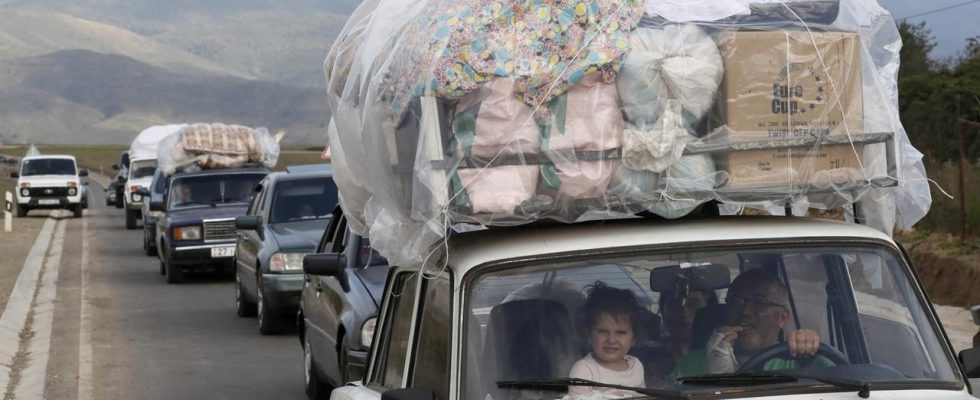report
The last refugees from Nagorno-Karabakh are expected in Armenia this weekend. When they arrive, they have an ordeal behind them. With despair and sadness comes anger and determination.
Two women in their early 30s sit exhausted in the shade of a tent made of camouflage fabric. Narine and Gajane are two young Armenian entrepreneurs who came to the border with Azerbaijan as volunteers.
For days they have been handing out bread, fruit and drinks to those who survived the two-day ordeal through the Lachin corridor on Azerbaijani territory in cars, buses and the backs of trucks. The two women are two of about a hundred who set out privately to provide help at the first stop on the Armenian side.
Narine says her grandparents came from Nagorno-Karabakh but had lived in Armenia for a long time. She is glad that the two of them do not have to experience this exodus from their homeland, she says crying. Tears are also rolling down her friend’s cheeks. It is heartbreaking for them that they will no longer be able to go to Nagorno-Karabakh for a long time.
The Lachin Corridor is the only connection between Nagorno-Karabakh and Armenia.
Only connection
Its mountainous silhouette stands out in the haze. A bright, ocher stripe runs through the barren mountains in front of it – the road of the Lachin corridor. Azerbaijan had blocked this only connection between Nagorno-Karabakh and Armenia in recent months and interrupted the supply of electricity and gas from Armenia.
The Armenian Red Cross provides first aid in a white plastic tent a few meters from the volunteers’ tents. When asked about the number of patients treated, a doctor’s assistant in her late 40s bursts into anger. “Armenia is the oldest Christian nation in the world. Where is the charity of all the other Christian nations? We are being left alone here in the second genocide against us Armenians,” she complains, recalling the genocide of the Armenians in the Ottoman Empire in 1915.
According to estimates, more than 1,000 people arrived every hour until Friday. The Azerbaijani border officials have now given up checking the papers of those arriving. Several people say they just counted the people in the cars and briefly opened the trunk.
First reunion after the escape
Many cars stop on the road to the next larger town, Goris, and the occupants rest behind trees in the adjacent fields. Two young men hug each other; it is their first reunion after their hasty escape.
The refugees stowed what they could just take with them in the trunks and on the roofs – clothes, pillows, blankets, household items. A piece of fitness equipment is piled up on the roof of a car, and the packaging for a TV screen protrudes over the rear window of another car.
Vehicles are piled up at the first gas station on the way to Goris. Inga, 46, stands a little ways away, surrounded by small children and two women. She is from Stepanakert, the capital of Nagorno-Karabakh.
They took their elderly neighbor, who doesn’t have her own car, with them. Now they all don’t know where they can stay. Could she imagine returning one day? Not as long as the Azerbaijanis are in charge there, answers Inga. She served as a soldier for almost 20 years.
Escaped after soldiers shot a woman
The people in the cars are tired, stressed and driven by existential worries. For example, they don’t know whether they will be able to access their deposits at the bank in Nagorno-Karabakh. The Armenian government is now providing the displaced people with a credit of the equivalent of almost 250 euros per person, as well as a free cell phone contract and free transport on public transport for six months.
But you have to register for this; you can do this in Goris. Many cars break down on the way there. The 69-year-old Serjschek is looking for a spare part. He comes from the village of Martuni in Nagorno-Karabakh. They fled with little more than their documents and a few photos after Azerbaijani soldiers shot a woman.
On the way to Stepanakert they were stopped and questioned by Azerbaijani journalists. They argued that we could live peacefully together. Seryshek bursts into tears. Yes, he studied in Baku during Soviet times and met student friends in Moscow decades later. But that is over.
The people from Nagorno-Karabakh arrive in Goris and are initially taken care of.
Help for the refugees
The arrivals’ vehicles are piled up around the central square in Goris. The Red Cross and the United Nations World Food Program have set up tents. Old people sit between their belongings listlessly and with a blank stare. In between, children play catch and their parents talk on the phone.
Many residents in Goris and other places are helping. The saleswoman at a textile store says that they provide children’s clothing. She, too, cannot hold back tears in the face of the tragedy. A restaurant owner turns away because tears are taking away his voice.
The last refugees from Nagorno-Karabakh are expected this weekend. The United Nations expects that the number will then reach 120,000.
On the way to Yerevan
Many refugees also make their way to the capital Yerevan in the evening. In the dark, tired and stressed drivers overtake each other in breakneck maneuvers, and accidents occur several times. A family continues to drive despite a dent and a splintered window in the driver’s door.
Many will now be staying with relatives for some time. But in the long term they need housing and work. The majority of Armenians in Nagorno-Karabakh worked as farmers, with a few people working in the service sector. There is a need for workers in Armenia, but the refugees would have to be qualified to do so.
13-year-old Anusch knows what she wants to be: a doctor. So that she can help in the next war when the Armenians retake Nagorno-Karabakh, she says.

